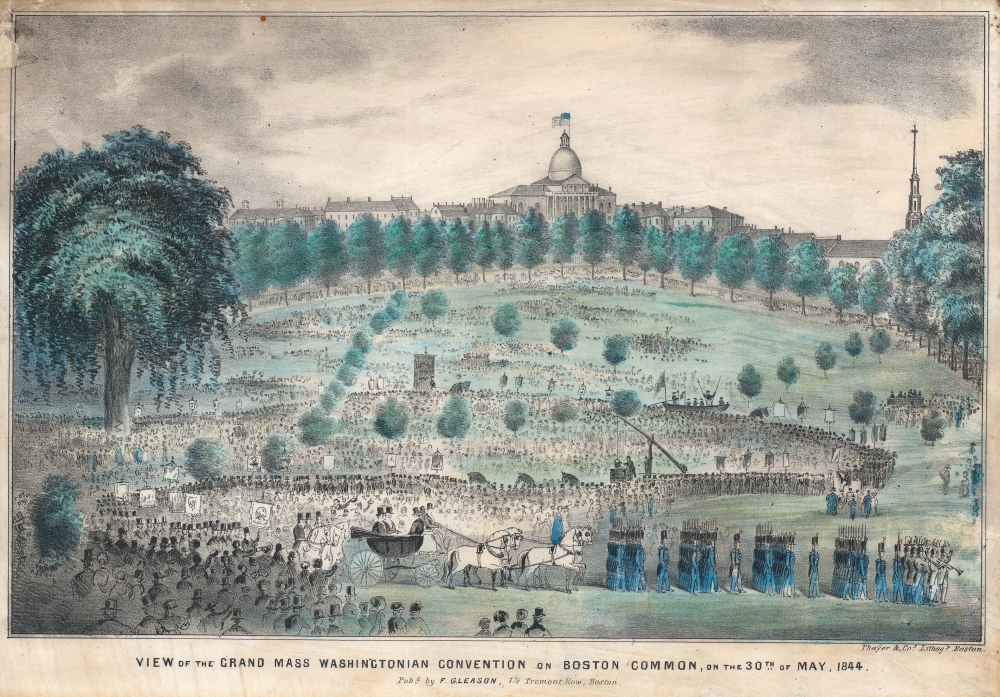1844 Thayer View of Boston Common and a Washingtonian Convention
WashingtonianConvention-thayer-1844
Title
1844 (dated) 9.5 x 13.75 in (24.13 x 34.925 cm)
Description
A Closer Look
With the State Capitol, Park Street, and Park Street Church in the background, thousands of Washingtonians are illustrated assembled on Boston Common. Soldiers in dress uniforms and dignitaries in a carriage pulled by while horses occupy the foreground, and many Washingtonians appear holding banners.The Washingtonian Movement
The Washingtonian Movement was a 19th century American temperance society. Six alcoholics founded the society at Chase's Tavern in Baltimore, Maryland, on Thursday, April 2, 1840. The six men, with the goal of complete abstinence from alcohol, started from the idea that by relying on one another, creating an atmosphere of conviviality, and sharing their alcoholic experiences, they would be able to support each other and keep sober. By speaking about their experiences and how the Society had helped them remain sober, the Society continued to gain new members. While the Washingtonians advocated for temperance, their focus was on the individual, as opposed to many other 19th century temperance organizations that dwelt on society's wider relationship to liquor. At its peak, tens of thousands of individuals were members, with some estimates of memberships numbering in the hundreds of thousands. Unfortunately, the Society disappeared as quickly as it appeared. Attention drifted from the group's main focus, sobriety, with members moving to support divisive subjects including prohibition, sectarian religious movements, and abolition. In 1935, when Alcoholics Anonymous was founded, in many respects the Washingtonians spiritual successors, AA's founders were completely unaware the existence of the Washingtonians.Publication History and Census
This view was lithographed by Benjamin Thayer and published by Frederick Gleason c. 1844. We note two cataloged examples: Boston Athenaeum and the American Antiquarian Society.CartographerS
Benjamin W. Thayer (1814 - December 17, 1875) was a Boston based lithographer, newspaper investor, and real-estate broker active in the middle part of the 19th century. Thayer published as 'B. W. Thayer and Company.' He appears to have had two periods of activity, between 1840 and 1847 and between 1851 and 1853. In 1840 he took over the shop of William S. Pendleton and Moore, which he rand with his brother-in-law, John H. Bufford, and John E. Moody. He abandoned the partnership in 1846, establishing himself at 208 Washington Street as a 'fancy goods seller' and lithographer. He does not appear in the Boston Directory between 1848 and 1850, suggesting he was no longer active. He reestablished his partnership with Bufford in 1851 and appears again in the Directory until 1853, when he sold the shop to S. W. Chandler. He leveraged the assets of the sale to become a wealthy newspaper investor and real estate agent. More by this mapmaker...
Frederick Gleason (c. 1817 – November 6, 1896) was an American magazine publisher active in Boston during the second half of the 19th century. Gleason was born in Germany and immigrated to the United States as a young man. He studied as a bookbinder but quickly moved into publishing. After some initial success publishing the short stories of 'hack authors', Gleason transitioned into the publication of a weekly story paper, The Flag of our Union in 1845. The publication became popular, with some 75,000 copies in circulation, making Gleason a man of means. In 1851, inspired by the London Illustrated News he began, in partnership with Maturin Murray Ballou, to publish Gleason's Pictorial Drawing-Room Companion. The Companion proved popular and inspired other publications including the New York Daily Times and Harper's Weekly. Gleason sold his share of the Companion to partner Ballou, in 1854, after which it was published as Ballou's Pictorial Drawing-Room Companion. Gleason began speculating in the stock market, both making and loosing fortunes until, with the onset of a financial crises, he found himself in ruin. Learn More...

